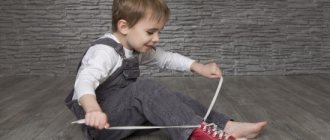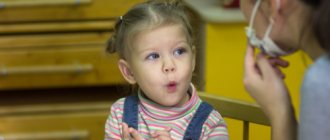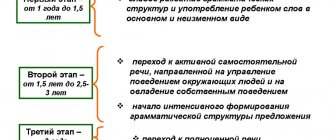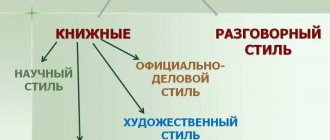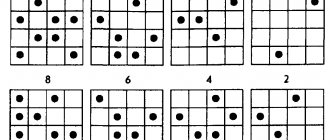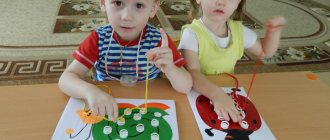Features of speech of four-year-old children
The level of speech development during this age period greatly depends on the level of family upbringing and on the quality of education children receive in a preschool institution. This difference becomes more noticeable the closer he gets to the five-year mark.
If in kindergarten he was lucky enough to get a sensitive teacher who understands the importance of the speech development of preschoolers, we can assume that by the beginning of school he will come with a solid baggage of developed and figurative speech, and with reading and writing in the first grade he will not have much. problems.
In families where they brush aside the child’s attempts to communicate or ask about what interests him, where there is not a single children’s book in the house, and all the responsibilities dedicated to the development of children, mom and dad transferred to the kindergarten, nannies and their parents, beautiful and Correct speech in a child at the beginning of school is very rare.
Lexicon
From four to five years, a child’s vocabulary increases from two and a half to three thousand words. Such a wealth of vocabulary gives him the opportunity to accurately name objects and their qualities (strong, cheerful, strong, thin, tall, long, small). Children with the ability to create words actively come up with their own words. Each parent can, if desired, recall more than one example of such words invented by their children at this age.
Vsekhniy is general, melkoscope is a microscope, oggnata are sparks of fire - these examples of word creation are given in his book “From Two to Five” by the researcher of children’s speech, writer K.I. Chukovsky. In addition to actively learning new words, children enjoy playing with rhymes, inventing their own poems. These poems may consist of strange combinations of sounds that are not similar to any word we know (“And I came up with a word, the funny word “plyam”). You should not condemn a child for such a meaningless activity, from the point of view of adults. Little poets train their ear for speech in this way, learning to select words that sound similar in sound.
The normal speech development of children aged 4–5 years leads to the fact that more and more adjectives appear in the dictionary, since clarification of the qualities and characteristics of objects is now in the foreground in speech. The color of the item is now not only blue and red, it can be pink, lilac, dark and light, blue and orange.
In the speech of a four-year-old child there are more prepositions, they become more complex (because of, from under). The number of personal pronouns is increasing, they are increasingly used as predicates (I, we, you, you). Occasionally you can hear collective nouns, which he now uses to the place (vegetables, fruits, dishes, furniture).
Grammar of children's speech
At this age, children are already able to construct a logically correctly formed statement from several phrases. Sentences can be not only simple, but also complex. (We'll put on boots because it's cold. They bought me candy and my brother some cookies).
The rapid development of speech, the desire to speak out, a sharp jump in the number of words mastered leads to the fact that errors are often encountered in speech:
- the structure of sentences is disrupted;
- There is an incorrect agreement on gender and number (two chairs, blue tights);
- verbs change incorrectly (we want, they laugh).
Despite the shortcomings encountered, in most cases children correctly formulate their statements and begin to master monologue speech. Not immediately, with the help of an adult, children master retelling a short text, read story or fairy tale. Four-year-olds notice mistakes in the speech of their peers, but hardly notice their own shortcomings.
Sound pronunciation
The child grows, and along with the rest of the muscles, the muscles of the articulation organs, especially the lips and tongue, become stronger and more coordinated. It becomes noticeable that children correctly pronounce most polysyllabic words, without rearranging syllables, place stress correctly, and their speech is close to the literary norms of their native language. If work on the development of speech hearing was previously carried out in a family or in a kindergarten, now children can already recognize sounds by ear and come up with words for a given sound.
At the age of four, many children have mastered the pronunciation of all sounds; they pronounce them clearly and clearly. Some articulation deficiencies that occur at this age are considered the age norm and can disappear over time without correction and special classes:
- the use of hissing and whistling sounds can be unstable, correct in some words and incorrect in others (fur coat - skola, toad - zuk, cheeks - mesh);
- the sounds l and r, although correctly pronounced in isolated form, are not always pronounced correctly in words; children replace them with other sounds (yoshad - horse, movoko - milk, yuki - hands, Malina - Marina);
- indistinctly pronounces unfamiliar words.
The help of a speech therapist is required in cases of obvious lisp (interdental [s] and [z]) and a graduated pronunciation of the sound [r], when it is not the tip of the tongue that vibrates, but the soft palate or a small tongue in the pharynx (“French pronunciation”, “burr”). Once such defective pronunciation takes hold, it will be very difficult to correct it later. Correcting the grazing sound [r] may take from a year to a year and a half. If there are doubts about whether the child pronounces this sound correctly, you need to ask him to pronounce it with his mouth open. If the sound [r] is defective, this cannot be done.
We teach in the game
After analyzing the above norms, parents can understand which areas of their child’s speech need to be developed first: those with which there are problems. To correct each individual area, you can select appropriate games for speech development. First of all, to expand your vocabulary. Here are some examples of such games.
- The adult names the object, and the child must put this word in the plural (wall - walls). In the course of such a game, you can also touch on polysemy (for example, a child, a chair or a seat can have a back, and a mug in the plural, only with a different emphasis - these are both geometric figures and sections for creative activities). At the same time, the child’s attention is promptly focused on the fact that not all words “multiply” equally (lion - lions, mouth - mouths). This develops the skill of using the plural and expands your vocabulary.
- You can introduce your child to antonyms by offering to select opposite meanings for words (soft - hard, clean - dirty). At the same time, let him select words with new meanings (white snow - black night), and then replace them with pronouns (he is white, she is black). This way the preschooler will practice agreeing words and using pronouns.
- After reading a story or poem, you can invite your child to come up with his own ending. It also develops thinking, imagination and coherent speech.
- Playing with a ball allows you to develop various skills: enrich your vocabulary, master synonyms, antonyms, recognize objects by description, form new forms of words. For example, a child is thrown a ball, naming the object, and he returns the ball, calling the object affectionately. Or in response to a word it selects the opposite meaning. Or names an object, having heard its signs, names the color of the specified object. Parents' imagination can suggest other options for such games.
- Animate and inanimate objects. The concept of them can be easily reinforced by playing with cards: the child must put animate objects in one group, inanimate ones in another, helping himself with questions: “This is a pear. She is alive? No. This is a cow. She is alive? Yes".
- Using a similar exercise, you can introduce your baby to relative adjectives. One group of cards will contain objects, the other will contain the materials from which they are made. The child’s task is to correlate the two pictures, saying: the ball is made of rubber. It's rubber. The pencil is made of wood. It is wooden.
In order for a preschooler’s speech to become more expressive, offer him such a game (several children or a family should play). The child, on the instructions of the adult, must demonstrate to the other players different shades of a person’s mood (fun, surprise, sadness, anger, fatigue, despondency). In this case, the baby can use appropriate intonation, facial expressions, interjections (oh-oh, wow, wow, eh, ah, ah-ah). The rest of the players guess what exactly was shown.
The norm of speech development of children of the fifth year of life
The state of children's speech at the age of four to five years can be very different: from perfect command of the capabilities of their native language to very slurred statements with a meager vocabulary and a lot of grammatical errors.
Guidelines that you can rely on when analyzing the state of children’s speech:
- a child of five years of age uses words exactly according to their meaning;
- in addition to the main parts of speech, he actively uses adjectives, adverbs, and pronouns;
- children can quite fully describe toys, objects, pictures;
- most sounds are pronounced clearly and correctly, although the articulation of [l] and [r] may not yet be mastered;
- he is able to control the volume of his speech and can speak in a whisper;
- the pace of statements is average, without slowness or excessive haste;
- When reciting poetry and telling fairy tales, children use expressive intonation.
In the fifth year of life, children can already speak faster and slower, pronounce words quieter and louder, and notice these nuances in the speech of other people. Kids add an interesting emotional color to their statements and use intonation to express their messages. This allows them to recite poems they have learned by heart with greater artistry.
The main quality of children's speech at this age is its coherence and consistency in the presentation of thoughts.
Speech delay
In rare cases, at this age there may be children who not only cannot speak fluently, but also cannot compose a simple sentence of 2-3 words. Non-speaking children by this age should cause concern among parents, since delayed speech development in children 4 years old requires immediate correction and intervention from specialists. Possible reasons for this lag could be:
- problems in the field of neurology;
- intellectual impairment, mental retardation;
- suffered birth trauma, pathology of pregnancy in the mother of the baby;
- problems with motor skills of the organs of articulation (“cleft palate”, cleft soft palate);
- social neglect, lack of communication with adults.
Another type of speech delay that does not always cause concern for parents is the child’s unintelligible speech, especially if, according to the parents, “he understands everything, he just can’t say it.” Children with unintelligible speech are characterized by the following disorders:
- incorrect pronunciation of polysyllabic words (ignusinny - toy, tivilizil - TV), syllables and sounds are rearranged and missing in words;
- cannot answer an adult’s question with a common sentence, his answers are monosyllabic;
- he cannot finish a sentence started by an adult, talk about an object, a toy, a picture;
- the vocabulary is poor, limited to a primitive set of words most often used in everyday life;
- finds it difficult to select the right words, may confuse them if they are similar in sound but different in meaning;
- His articulation lacks the pronunciation of most sound groups: hissing, whistling, frequent substitutions of sounds, he does not notice speech errors in himself and those around him.
Exercises and tasks
The main exercises and tasks that need to be done daily at home for the active development of coherent speech are:
Articulation gymnastics
- Eat some jam. You need to imagine that after eating the pie there is jam left on your lips that needs to be licked. Using your tongue, smoothly lick the jam from the lower and upper lips.
- Spade tongue. It is necessary to imagine that the tongue is a shovel, which should lie on the stand (lower lip) for as long as possible. We extend the tongue, placing it on the lower lip, and hold it in this position for 10-15 seconds.
- The tongue is a needle. You need to imagine that the tongue is a thin needle that needs to be held in place. We stretch out our tongue, trying to make it narrow, and try to hold it for 10-15 seconds.
- I'm a horse. The child needs to imagine himself as a horse that clatters its hoofs and clicks its tongue. We stomp our right and left feet in turn, clicking our tongue as we do so.
These exercises are best done for no more than 5-7 minutes and repeated 2 times a day.
It’s more fun to do articulation gymnastics with children by looking at pictures and reading rhymes.
Finger games
- Kitty. Both palms are clenched into fists and lie on a flat surface. It is necessary to simultaneously straighten the fingers on both handles, pressing them tightly to the table. The exercise must be repeated 4-5 times. After several lessons, the task can be complicated: first, the fingers on one hand are straightened, then they are compressed, and on the second they are straightened.
- Let's treat the cat with milk. Palms as if scooping out milk.
- Bunny. The fingers imitate the ears of a bunny, the fingers run along the table, clenched into a fist, fist in fist.
- Dog. The index finger shows the tail of the dog, the fingers are clenched into a fist, the thumb is raised up, the fingers run away.
Using finger games with parallel learning of rhymes can show quite good results, since there is a strong relationship between the human hand and the speech center of the brain. The baby easily and more emotionally perceives information and reproduces it in the future without problems.
Logorhythmics
Logorhythmics is the simultaneous reading of poetry, accompanied by a certain set of movements against the background of thematic music. Initially, the adult shows everything by example, after which the child is asked to repeat what he just saw.
The optimal time to complete this task is the second half of the day, the regularity of classes is every 1-2 days.
A special place in speech development classes is given to cartoons, which children love so much. There are specially designed cartoons aimed at reinforcing the letters of the alphabet, learning colors, learning to count and speech development.
The choice of cartoons remains up to the parents, but a prerequisite is its versatility (for both boys and girls), the presence of positive characters, and high quality video and sound.
Diagnosis of speech disorders
To check on your own how things are going with speech disorders in a child who speaks incomprehensibly, you can conduct several simple tests. To study vocabulary, he is asked to name animals, seasons, dishes, toys, furniture from pictures.
Children are asked to name objects, phenomena, qualities of objects, to carry out an assignment (draw something, bring an object or toy). To find out how they can change words, they offer the following tasks:
- form the plural (nose – noses, chair – chairs),
- offer to count objects, determining how he coordinates nouns with numerals (one book, two books, etc.);
- say “affectionately” (doll - doll, bed - crib).
To determine the level of development of phrasal speech, children are asked to complete a sentence started by an adult: “The boy... is playing ball.” For this, pictures with different scenes are used. When observing a child’s speech in everyday life, you need to note for yourself which parts of speech the child uses and evaluate his ability to correctly construct a phrase.
To examine the syllabic structure of a word, the child is offered verbal tasks without using pictures: repeat syllables from different consonants and vowels (lo-se-ku, pi-ka-chu), syllables from the same consonants and different vowels (da-doo-dy-do) , from the same vowels and different consonants (la-ma-ka-sa). To understand whether the child feels the rhythm of speech, they tap the rhythm of a simple word and ask him to repeat it in the same way.
